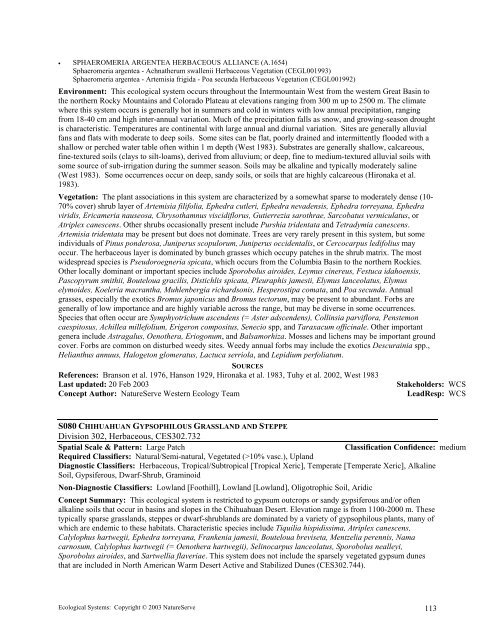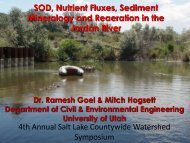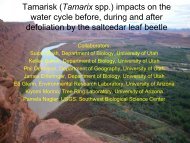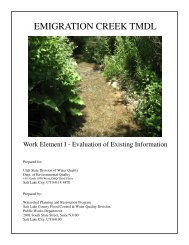landcover descriptions for the southwest regional gap analysis project
landcover descriptions for the southwest regional gap analysis project
landcover descriptions for the southwest regional gap analysis project
You also want an ePaper? Increase the reach of your titles
YUMPU automatically turns print PDFs into web optimized ePapers that Google loves.
• SPHAEROMERIA ARGENTEA HERBACEOUS ALLIANCE (A.1654)Sphaeromeria argentea - Achna<strong>the</strong>rum swallenii Herbaceous Vegetation (CEGL001993)Sphaeromeria argentea - Artemisia frigida - Poa secunda Herbaceous Vegetation (CEGL001992)Environment: This ecological system occurs throughout <strong>the</strong> Intermountain West from <strong>the</strong> western Great Basin to<strong>the</strong> nor<strong>the</strong>rn Rocky Mountains and Colorado Plateau at elevations ranging from 300 m up to 2500 m. The climatewhere this system occurs is generally hot in summers and cold in winters with low annual precipitation, rangingfrom 18-40 cm and high inter-annual variation. Much of <strong>the</strong> precipitation falls as snow, and growing-season droughtis characteristic. Temperatures are continental with large annual and diurnal variation. Sites are generally alluvialfans and flats with moderate to deep soils. Some sites can be flat, poorly drained and intermittently flooded with ashallow or perched water table often within 1 m depth (West 1983). Substrates are generally shallow, calcareous,fine-textured soils (clays to silt-loams), derived from alluvium; or deep, fine to medium-textured alluvial soils withsome source of sub-irrigation during <strong>the</strong> summer season. Soils may be alkaline and typically moderately saline(West 1983). Some occurrences occur on deep, sandy soils, or soils that are highly calcareous (Hironaka et al.1983).Vegetation: The plant associations in this system are characterized by a somewhat sparse to moderately dense (10-70% cover) shrub layer of Artemisia filifolia, Ephedra cutleri, Ephedra nevadensis, Ephedra torreyana, Ephedraviridis, Ericameria nauseosa, Chrysothamnus viscidiflorus, Gutierrezia sarothrae, Sarcobatus vermiculatus, orAtriplex canescens. O<strong>the</strong>r shrubs occasionally present include Purshia tridentata and Tetradymia canescens.Artemisia tridentata may be present but does not dominate. Trees are very rarely present in this system, but someindividuals of Pinus ponderosa, Juniperus scopulorum, Juniperus occidentalis, or Cercocarpus ledifolius mayoccur. The herbaceous layer is dominated by bunch grasses which occupy patches in <strong>the</strong> shrub matrix. The mostwidespread species is Pseudoroegneria spicata, which occurs from <strong>the</strong> Columbia Basin to <strong>the</strong> nor<strong>the</strong>rn Rockies.O<strong>the</strong>r locally dominant or important species include Sporobolus airoides, Leymus cinereus, Festuca idahoensis,Pascopyrum smithii, Bouteloua gracilis, Distichlis spicata, Pleuraphis jamesii, Elymus lanceolatus, Elymuselymoides, Koeleria macrantha, Muhlenbergia richardsonis, Hesperostipa comata, and Poa secunda. Annualgrasses, especially <strong>the</strong> exotics Bromus japonicus and Bromus tectorum, may be present to abundant. Forbs aregenerally of low importance and are highly variable across <strong>the</strong> range, but may be diverse in some occurrences.Species that often occur are Symphyotrichum ascendens (= Aster adscendens), Collinsia parviflora, Penstemoncaespitosus, Achillea millefolium, Erigeron compositus, Senecio spp, and Taraxacum officinale. O<strong>the</strong>r importantgenera include Astragalus, Oeno<strong>the</strong>ra, Eriogonum, and Balsamorhiza. Mosses and lichens may be important groundcover. Forbs are common on disturbed weedy sites. Weedy annual <strong>for</strong>bs may include <strong>the</strong> exotics Descurainia spp.,Helianthus annuus, Halogeton glomeratus, Lactuca serriola, and Lepidium perfoliatum.SOURCESReferences: Branson et al. 1976, Hanson 1929, Hironaka et al. 1983, Tuhy et al. 2002, West 1983Last updated: 20 Feb 2003Concept Author: NatureServe Western Ecology TeamStakeholders: WCSLeadResp: WCSS080 CHIHUAHUAN GYPSOPHILOUS GRASSLAND AND STEPPEDivision 302, Herbaceous, CES302.732Spatial Scale & Pattern: Large PatchClassification Confidence: mediumRequired Classifiers: Natural/Semi-natural, Vegetated (>10% vasc.), UplandDiagnostic Classifiers: Herbaceous, Tropical/Subtropical [Tropical Xeric], Temperate [Temperate Xeric], AlkalineSoil, Gypsiferous, Dwarf-Shrub, GraminoidNon-Diagnostic Classifiers: Lowland [Foothill], Lowland [Lowland], Oligotrophic Soil, AridicConcept Summary: This ecological system is restricted to gypsum outcrops or sandy gypsiferous and/or oftenalkaline soils that occur in basins and slopes in <strong>the</strong> Chihuahuan Desert. Elevation range is from 1100-2000 m. Thesetypically sparse grasslands, steppes or dwarf-shrublands are dominated by a variety of gypsophilous plants, many ofwhich are endemic to <strong>the</strong>se habitats. Characteristic species include Tiquilia hispidissima, Atriplex canescens,Calylophus hartwegii, Ephedra torreyana, Frankenia jamesii, Bouteloua breviseta, Mentzelia perennis, Namacarnosum, Calylophus hartwegii (= Oeno<strong>the</strong>ra hartwegii), Selinocarpus lanceolatus, Sporobolus nealleyi,Sporobolus airoides, and Sartwellia flaveriae. This system does not include <strong>the</strong> sparsely vegetated gypsum dunesthat are included in North American Warm Desert Active and Stabilized Dunes (CES302.744).Ecological Systems: Copyright © 2003 NatureServe 113





